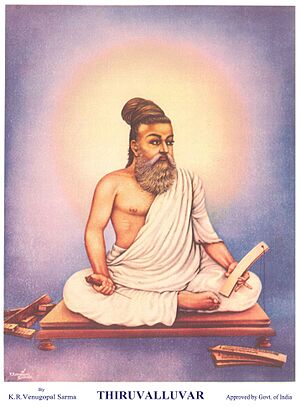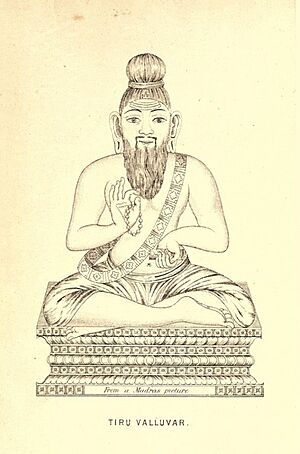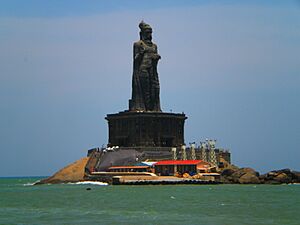Thiruvalluvar facts for kids
Quick facts for kids
Thiruvalluvar
|
|
|---|---|

Artistic modern depiction of Thiruvalluvar
|
|
| Born | Uncertain Birthplace unknown; probably Mylapore
|
| Other names |
|
|
Notable work
|
Kural |
| Spouse(s) | Vasuki |
| Region | Tondai Nadu of Tamil nadu |
| School | Indian philosophy |
| Notable students | Elelasingan |
|
Main interests
|
|
|
Notable ideas
|
Common ethics and morality |
|
Influences
|
|
|
Influenced
|
|
Thiruvalluvar (Tamil: திருவள்ளுவர்), also known as Valluvar, was a famous Tamil poet and philosopher. He is most known for writing the Tirukkuṟaḷ. This book is a collection of short poems called couplets. These couplets share ideas about good behavior (ethics), how to run a government (politics), money matters (economics), and love. The Tirukkuṟaḷ is a very important and loved book in Tamil literature.
We don't have much true information about Valluvar's life. Scholars like Kamil Zvelebil say that details about him are mostly guesses from his writings. There are many old stories about Valluvar, but they are not proven to be true. Different religions, and even Christian missionaries in the 1800s, tried to say he belonged to their group. We don't know for sure about his family, religion, or where he was born. People believe he lived in Mylapore (now part of Chennai). His time period is thought to be anywhere from 400 BCE to 500 CE. Some say he was born in 31 BCE, while others suggest around 500 CE.
Valluvar's ideas have inspired many thinkers over time. His work covers topics like ethics, society, politics, and spirituality. He is seen as a great wise person, and his writings are a classic part of Tamil culture.
Contents
About Valluvar's Life
We know very little for sure about Valluvar's life. We don't even know his real name or the original name of his famous book. The Tirukkuṟaḷ itself doesn't say who wrote it. A French translator in the 1800s called it "the book without a name by an author without a name." The name Thiruvalluvar (meaning 'Saint Valluvar') appeared later in a text called Tiruvalluva Maalai.
Most ideas about Valluvar's life come from his book and other Tamil writings that mention him. Scholar Zvelebil thinks Valluvar was likely a learned Jain person. He probably knew a lot about early Tamil writings and some ancient Indian legal texts.
Old Stories About Valluvar
The Tiruvalluva Maalai is an old Tamil text that first mentions stories about Valluvar. This text links the Kural to ancient Sanskrit writings. Some old comments on this text say Valluvar was "born in a low caste," but the original text does not say this. These stories might have come from spoken traditions. No other old texts before the colonial era support these legends about Valluvar's life. Many legends about him were published starting in the 1800s.
During the colonial period, people made many claims about Valluvar's family and job. These ideas came from picking certain parts of his book or from new stories. One story says he was a Paraiyar weaver. Another idea is that he was from the Vellalar farming group because he praised farming in his book. Some even said he was born to a Pariah woman and a Brahmin father.
Many scholars believe Valluvar was married to a woman named Vasuki. They likely lived in Mylapore. Traditional stories say Valluvar passed away on the day of Anusham in the Tamil month of Vaikasi.
A poem called Kapilar Agaval claims to be written by Valluvar's brother, Kapilar. It says they were children of a Pulaya mother named Adi and a Brahmin father named Bhagwan. This poem states they had seven children, including Valluvar. However, scholars say this story is not true. The poem Kapilar Agaval was likely written much later, around the 1400s.
These old stories about Valluvar are not always the same. They also contain claims that are hard to believe. For example, some say he met a legendary sage on a mountain. Others say he performed miracles, like making a ship float or his wife cooking sand into rice. Scholars believe these parts of the stories are just fiction, like many old folk tales. The claims about his birth, whether high or low caste, are also doubtful.
By 1904, a scholar named Purnalingam Pillai said these traditional stories were myths. His ideas are still considered strong today. These fictional stories about Valluvar became popular because Christian missionaries and European writers accepted them. They were widely published and became part of what people learned about Tamil history.
When Did Valluvar Live?
The exact time Valluvar lived is not clear. His book, Tirukkuṟaḷ, has been dated from 300 BCE to about 600 CE. Some old stories say it was the last work of the third Sangam period. Scholars who believe this, like Somasundara Bharathiar, date the book as early as 300 BCE. However, scholar Zvelebil says these very early dates are not supported by evidence in the text itself.
The way the Tirukkuṟaḷ is written, and its links to older Sanskrit texts, suggest Valluvar lived after the early Tamil poets. But he lived before the time of the Tamil bhakti poets.
In the 1950s, S. Vaiyapuri Pillai suggested the book was written around or after 600 CE. He noted that the Tirukkuṟaḷ uses many words borrowed from Sanskrit. It also seems to know about Sanskrit texts from the first half of the first millennium CE. Later studies showed that some of these words were actually Tamil, but many still came from Sanskrit.
Kamil Zvelebil believes the Tirukkuṟaḷ is not from the earliest Sangam period. In the 1970s, he estimated the text was written between 450 and 500 CE. This is based on how the Tamil language changed over time. He also noted that some of Valluvar's verses seem to be translations of ideas from Sanskrit classics.
Today, most scholars agree that the Tirukkuṟaḷ and its author lived around 500 CE.
In 1935, the Tamil Nadu government officially recognized 31 BCE as Valluvar's birth year. This was suggested by Maraimalai Adigal. The Valluvar Year is now part of the calendar. To find the Valluvar year, you add 31 to any year in the common era.
Where Was Valluvar Born?
Just like other details about Valluvar, his exact birthplace is not known for sure. People believe Valluvar lived in Madurai and later in Mylapore (now part of Chennai). Some stories say he was born in Mylapore and then moved to Madurai to share his work.
The poem Kapilar Akaval says Valluvar was born under an iluppai tree in Mylapore. However, verse 21 of the Tiruvalluva Maalai claims he was born in Madurai.
In 2005, a research team claimed Valluvar was born in Thirunayanarkurichi, a village in the Kanyakumari district. This claim came from an old Kani tribal leader. The leader said Valluvar was a king who ruled a territory called "Valluvanadu" in the hills of Kanyakumari.
What Was Valluvar's Religion?
People generally think Valluvar belonged to either Jainism or Hinduism. These were two major religions in India during his time, along with Buddhism. In the early 1800s, some writers thought Valluvar might have been a Jain. An 1819 translation mentioned that people in Tamil Nadu debated if he was a Jain or a Hindu.
Kamil Zvelebil believes the ideas in the Tirukkuṟaḷ are like the Jain moral code. This is especially true for ideas about not eating meat (moral vegetarianism) and not harming living things (ahimsa). Valluvar also talks about finding freedom from rebirth by living with a kind heart. Zvelebil points out that some names Valluvar uses for God in the Kural sound very much like Jain ideas.
However, other scholars believe Valluvar's writings suggest he was a Hindu. Hindu teachers have found similarities between his teachings and those in Hindu texts. The idea of ahimsa (non-violence) is important in both Jainism and Hinduism. While the Kural praises non-violence, it also talks about how a king must lead an army and punish criminals. This practical approach to war and justice is similar to Hindu teachings.
The Kural is divided into three parts: aram (virtue), porul (wealth), and inbam (love). These parts are similar to the four main goals in Hinduism: dharma (right conduct), artha (wealth), kama (desire), and moksha (spiritual freedom). The scholar Parimelalakar, who wrote an important commentary on the Kural, said that Valluvar's text covers the first three goals directly. It discusses spiritual freedom indirectly through ideas like giving up worldly desires.

In the beginning of the Kural, Valluvar mentions Indra, a Hindu god, as an example of someone who controls their senses. Tamil Hindu scholars say other ideas in Valluvar's text, like the Vedas, Hindu gods (Trimurti), and rebirth, are also found in Hindu texts. Some scholars believe Valluvar was a Hindu.
Valluvar mentions God Vishnu and Goddess Lakshmi in some couplets. This suggests he might have had Vaishnavite beliefs (a branch of Hinduism that worships Vishnu). Shaivites (who worship Shiva) also see Valluvar as a devotee of Shiva. They have placed his images in their temples.
Scholar Stuart Blackburn says the Tirukkuṟaḷ is not a religious devotion text. It doesn't make fun of or praise Brahmins or religious rituals. It's a practical book and not specifically a Shaivite or Vaishnavite text. Norman Cutler says that Parimelalakar's famous commentary interprets Valluvar's text through a Hindu viewpoint. This commentary made Valluvar's ideas fit well within Parimelalakar's understanding of Hinduism.
Other Religious Claims
Because the Kural doesn't clearly state a religion, almost every religious group in India, including Christianity, has claimed Valluvar and his work as their own. However, scholars do not support these claims. For example, Christian claims only appeared after missionaries came to India.
- Buddhism
The Dalit activist Iyothee Thass, who became a Buddhist, claimed Valluvar was originally a Buddhist. Thass said the name "Tirukkuṟaḷ" was a reference to the Buddhist Tripiṭaka (three main Buddhist scriptures). He believed the book was first called Tirikural ("Three Kurals") because it followed these three Buddhist scriptures. Thass also claimed that the story of Valluvar being the son of a Brahmin father and a Paraiyar mother was made up by Brahmins in 1825 to make a Buddhist text seem Hindu.
- Christianity
In the 1800s, Christian missionary George Uglow Pope claimed Valluvar might have met Christian teachers. He thought Valluvar learned Christian ideas and then wrote the "wonderful Kurral" with ideas similar to the "Sermon on the Mount." Pope believed Valluvar must have lived in the 800s CE for this theory to fit. However, many scholars, including other missionaries, disagree with these claims. They say the Kural has no real connection to Christian ideas. For example, the Kural's chapter on "no killing" applies to both humans and animals, which is different from the Bible's idea of killing.
In the 1960s, some Christians in South India suggested Valluvar was a student of Thomas the Apostle. They thought Thomas visited Chennai, and Valluvar heard his teachings. But later scholars have also disproved this idea. Zvelebil points out that the ethics in Valluvar's work are not Christian. They are more like the ideas found in Jainism, especially the strong focus on not eating meat and not killing.
Valluvar's Writings
The Tirukkuṟaḷ is the main book believed to be written by Valluvar. It has 1330 couplets, which are short, two-line poems. These are divided into 133 sections, with 10 couplets in each section.
- The first 38 sections are about good behavior and universal order (called aram in Tamil, similar to dharma).
- The next 70 sections are about how to govern a country and manage money (called porul in Tamil, similar to artha).
- The last 25 sections are about love and pleasure (called inbam in Tamil, similar to kama).
The section on politics and economics (porul) is the longest. In its 700 couplets, Valluvar mostly talks about how a state should be run and about warfare. Valluvar's work is very realistic and practical. It's not just a deep philosophical text. His teachings are similar to those found in an ancient Indian text called Arthasastra, but they also have some key differences.
In Valluvar's ideas about a state, the army is the most important part. He says a state needs a well-kept, well-trained army led by a good commander, ready for war. Valluvar describes a state using six main parts:
- Army (patai)
- Citizens (kuti)
- Treasury (kul)
- Ministers (amaiccu)
- Allies (natpu)
- Forts (aran)
He also suggests having strong forts, good infrastructure, and enough food stored for times of siege.
The Tirukkuṟaḷ has been translated into many languages around the world. It was translated into Latin in 1730, which helped European thinkers learn about it. The Tirukkuṟaḷ is one of the most respected books in the Tamil language.
Generally, the Tirukkuṟaḷ is seen as Valluvar's only work. However, some later texts on medicine, like Gnana Vettiyan (1500 verses) and Pancharathnam (500 verses), are also said to be by him. Many scholars believe these are from much later times (1500s and 1600s). They might have been written by someone else with the same name. These books are important for Tamil science and traditional Siddha medicine.
Besides these, 15 other Tamil texts have been linked to Valluvar. However, many scholars, like Devaneya Pavanar, say that Thiruvalluvar did not write these other texts.
See also
 In Spanish: Tiruvalluvar para niños
In Spanish: Tiruvalluvar para niños
- Sarvajna and Tiruvalluvar statues installation
- Valluvar Kottam
- List of Sangam poets
- Valluvar year
- Thiruvalla
- Kingdom of Valluvanad





